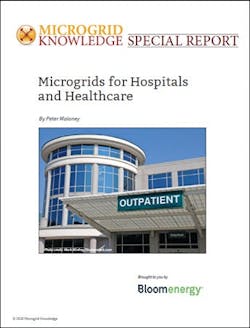Healthcare microgrids are on the rise from California to New England, as medical facilities seek ways to boost energy reliability and efficiency. Here we describe what’s driving the trend in the first entry of our new special report series on microgrids in hospitals.
Get the full report.
Microgrids are one of the fastest growing sectors within the electric power industry, and they are poised for even wider adoption in the wake of recent events, such as California’s wildfire-related power outages, which have jeopardized power reliability for crtical services.
In 2019, there were 25,281 blackouts, a 23% increase from the 20,598 blackouts in 2018, while the number of utility customers affected jumped to 28.4 million in 2019, up nearly 50% from 19 million in 2018. Overall, in a roughly two-year period ending December 31, 2019, there were more than 50,000 significant blackouts in California, affecting about 51 million electric customers, according to Bloom Energy.
California is also facing a rising level of forced outages. In the wake of deadly wildfires, the state’s investor-owned utilities received regulatory approval to de-energize transmission lines that could otherwise spark wildfires. These public safety power shutoffs (PSPS) cause homes and businesses to lose their power. Between October 2017 and October 2019, there were 2,374 PSPS events in the state, sometimes for days at a time or even, in one instance, for about one week.
Pacific Gas & Electric (PG&E), the state’s largest utility, has warned that the power shutoffs may be necessary for a decade. With unreliable power becoming a new normal for millions of Californians, interest has heightened in microgrids.
Because of the power outages, and other factors, private developers are installing microgrids throughout California for businesses, communities, institutions and government entities. One such microgrid is Blue Lake Rancheria, a tribal community in Northern California’s Humboldt County, which installed a microgrid in 2017 to reduce costs, improve power reliability and achieve its carbon reduction goals. But the microgrid proved to offer even greater benefits when its electrical service saved at least four lives in the fall of 2019.
Municipalities and businesses in regions across the country hard hit by disasters, ranging from wildfires and hurricanes to tornadoes and flooding, are realizing the benefits and relief that microgrids can provide.
Protecting health and safety are key reasons for building microgrids. The city of Fremont, California, installed microgrids at three of its fire stations. Originally built because the city wanted cleaner energy, the microgrids now ensure that the city’s emergency services will be able to function even if PG&E initiates a PSPS event.
California is an epicenter of microgrid development, but the technology is also taking off in other states. Municipalities and businesses in regions across the country hard hit by disasters, ranging from wildfires and hurricanes to tornadoes and flooding, are realizing the benefits and relief that microgrids can provide. Metropolitan Ministries, a nonprofit dedicated to providing services to the poor and homeless in Tampa, Fla., has to contend with life threatening hurricanes such as Irma in 2017. Concerned that it might not be able to serve its community the next time disaster strikes, the organization installed a microgrid that is able to provide it with emergency backup power.
Other essential, non-emergency services are also tapping into the benefits of microgrids. When high winds and tornadoes left about 140,000 people in the Dallas, Texas, area without electrical power last fall, four grocery stores in the region were able to continue to serve their customers when their backup microgrids switched on.
In January, Stop & Shop, a Northeast grocery chain, announced plans to install microgrids that use Bloom Energy fuel cells in 40 of its stores in Massachusetts and New York. The microgrids will run around the clock to ensure that the stores can serve customers even if the electric grid is experiencing an outage.
Healthcare microgrids from California to Massachusetts
With recent code changes, other generation sources can also be incorporated in the normal source capacity of a hospital’s essential electrical system. (Photo credit: Syda Productions/
Shutterstock.com)
Unlike many other businesses, hospitals and healthcare centers often operate around the clock. It is not surprising, then, that hospitals are also turning to microgrids, and that healthcare microgrids are on the rise.
From California to Massachusetts, medical facilities across the country are installing healthcare microgrids to help them achieve key goals. In California, Kaiser Permanente has installed a microgrid that it says will result in energy cost savings while enhancing reliability, resiliency and lower carbon emissions.
In New England, Partners HealthCare is installing 4.1 MW of Bloom Energy fuel cells across its footprint of medical, healthcare, administrative and data center facilities, including its corporate headquarters in Somerville, Massachusetts, its North Shore Medical Center and a data center in Marlborough, Massachusetts. For Partners HealthCare, enhancing sustainability is a top priority and installing fuel cells has enabled it to move closer to its sustainability goals.
Installing a microgrid can enable businesses to achieve one or more strategic goals, such as reliability, affordability and sustainability. Microgrids can ensure reliable operation by providing backup power. But, unlike other forms of backup power, such as diesel generators, microgrids can perform more than one function, giving them the ability to generate revenue and cut costs. And, depending on the type, a microgrid can improve the sustainability of an organization by lowering greenhouse gases and other emissions.
With recent code changes, other generation sources can also be incorporated in the normal source capacity of a hospital’s essential electrical system. Thus, when a utility outage occurs, these other sources can carry the hospital load in a microgrid capacity. In this scenario, the backup continues to be the ‘last line of defense’.
This extra layer of redundancy obtained from healthcare microgrids also allows hospitals to continue to perform elective surgeries during a power outage, thus improving patient health and comfort.
To better understand how a microgrid can achieve these goals requires a closer look at just what a microgrid is and what it can do.
Stay tuned for the following articles further exploring hospital microgrids:
- Types of Microgrids
- Microgrids in Hospitals
- Microgrids in Business Models
- Hospital Deployments and Microgrid Case Studies
Download the full report, “Microgrids for Hospitals and Healthcare,” free of charge courtesy of Bloom Energy.









